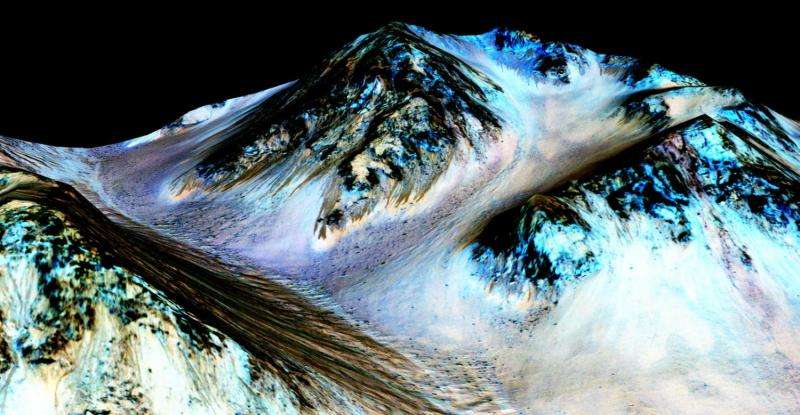These dark, narrow, 100 meter-long streaks called recurring slope lineae flowing downhill on Mars are inferred to have been formed by contemporary flowing water. Credit: NASA/JPL/University of Arizona
(Phys.org)—One of the biggest and most important findings made by NASA recently was the confirmation that liquid water currently flows on Mars. Scientists suspected this a long time ago, but really strong evidence was needed to confirm this hypothesis. Now, with the discovery of hydrated minerals on downhill flows, which are known as recurring slope lineae (RSL), we know that liquid water not only existed in the past on Mars, but also flows there in present day. But how does this breakthrough finding reflect our current knowledge about present-day Mars, and how could it change our understanding of the history of our reddish neighbor?
Scott Murchie of the Johns Hopkins University Applied Physics Laboratory (APL) is one of the co-authors of a paper published on Sept. 28 in the Nature Geoscience, which detailed the findings regarding liquid water on Mars. He stresses the importance of this discovery when it comes to our understanding of the history of the Red Planet.
"It's a small but very important modification to how we understand the history of Mars. From Viking, Mars Global Surveyor, and Mars Express images, we knew that billions of years ago, Mars had flowing water," Murchie told Phys.org.
Murchie is also the principal investigator for the Compact Reconnaissance Imaging Spectrometer for Mars (CRISM) – an important instrument onboard NASA's Mars Reconnaissance Orbiter (MRO). CRISM is a visible-infrared spectrometer tasked with finding traces of water, and it has achieved this goal perfectly by helping to detect signatures of hydrated minerals on Martian slopes.
"Mineralogic measurements from the CRISM on the MRO showed that when that ancient water occurred, it was persistent. Previous to MRO, though, the most likely features to have been carved by recent water were so-called gullies, which are forming today. However, MRO's measurements suggest that most, if not all, of the gullies form by 'dry' processes at low temperature, probably involving the sublimation of carbon dioxide ice, and not liquid water," Murchie noted.
Prior to the latest findings, RSL have been described as possibly related to liquid water. The hydrated salts would lower the freezing point of a liquid brine, just as salt on roads causes ice and snow to melt more quickly. CRISM was the instrument that enabled researchers to see RSL in detail and unveiled their secrets. Now we know that these dark features on the slopes are, indeed, liquid water.
"So prior to the discovery of RSL, it appeared that Mars' ancient water had completely dried up. Now we know that at least a little bit of liquid water has persisted on the margins to the present day," Murchie said.
This discovery now opens a window into other unsolved mysteries that are still baffling scientists, like the existence of microbial life on Mars. After the discovery of organic compounds on the Red Planet, the confirmed presence of liquid water is another piece of this scientific puzzle that could bring outstanding results if put together.
However, as Murchie remarked, it's still too early to draw serious conclusions concerning the hypothetical existence of life on Mars.
"The organic compounds probably come from meteorites, and the water may be very salty, perhaps too salty for life. It's very possible that there is water that life would find acceptable, but we just don't understand what conditions would be good enough for life beyond Earth," Murchie said.
He admits that in order to advance our knowledge regarding possible microbial activity on the Red Planet, a Mars sample-return mission is needed. The mission would bring back bits of Martian soil that could be precisely investigated here on Earth.
"Personally, I think that we will not know the answer until carefully selected samples of Mars soil are returned to Earth," Murchie concluded.
More information: Lujendra Ojha et al. Spectral evidence for hydrated salts in recurring slope lineae on Mars, Nature Geoscience (2015). DOI: 10.1038/ngeo2546
Journal information: Nature Geoscience
© 2015 Phys.org
























